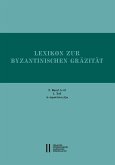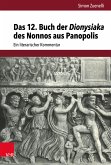Der vorliegende 8. und letzte Faszikel des Lexikons zur byzantinischen Gräzität (LBG) enthält die Wörter von ¿¿¿¿¿¿¿¿¿¿¿¿ zum Einpökeln bis ¿¿¿¿¿¿, ¿¿ Bleichheit, Blässe. Dazwischen findet man zahlreiche Komposita, die nicht selten in der Wissenschaftssprache bis in die Neuzeit Parallelen finden (vgl. The Oxford English Dictionary), besonders mit: ¿¿¿¿¿-, ¿¿¿-, ¿¿¿¿-, ¿¿¿¿-, ¿¿¿-, ¿¿¿¿-, ¿¿¿¿¿-, ¿¿¿¿¿¿-, ¿¿¿¿¿, ¿¿¿¿¿-, ¿¿¿¿¿-, ¿¿¿¿-. Seit der Bearbeitung des 7. Faszikels ist die Zahl der Editionen, die neu zu exzerpieren oder umzuzitieren waren, stetig angewachsen. Man findet diese in dem nun endgültigen kumulierten Abkürzungsverzeichnis. Auch diesmal waren es die elektronischen Medien, die weiteren Zuwachs brachten, insbesondere der "Thesaurus Linguae Graecae" (TLG), der im Zuge der Ausarbeitung des Manuskripts stets nach der neuesten Onlineversion verglichen wurde, um so die größtmögliche Aktualität zu erreichen. Dazu traten noch die fortgesetzte Berücksichtigung der Papyri (www.papyri.info, The Duke Collaboratory for Classics Computing & the NYU's Institute for the Study of the Ancient World) sowie gelegentlich auch der Inschriften (http://epigraphy.packhum.org, Searchable Greek Inscriptions. A Scholarly Tool in Progress.The Packard Humanities Institute). Insgesamt ergab sich so im Vergleich zu dem 7. Faszikel wieder ein Anwachsen des Umfangs um deutlich mehr als zehn Prozent. Schließlich ist das Problem, dass sich das unter der Leitung von Ioannis Kazazis fortgeführte Lexikon von Emmanuel Kriaras noch im Bereich Sigma befindet, auch diesmal für den Benützer so gelöst, dass aus vorhandenen Wörterverzeichnissen volkssprachlicher (auch nachbyzantinischer) Texte in der Lexikonzeile des LBG die jeweils wichtigsten Werke zitiert werden.
Dieser Download kann aus rechtlichen Gründen nur mit Rechnungsadresse in A, B, BG, CY, CZ, D, DK, EW, E, FIN, F, GR, HR, H, IRL, I, LT, L, LR, M, NL, PL, P, R, S, SLO, SK ausgeliefert werden.









